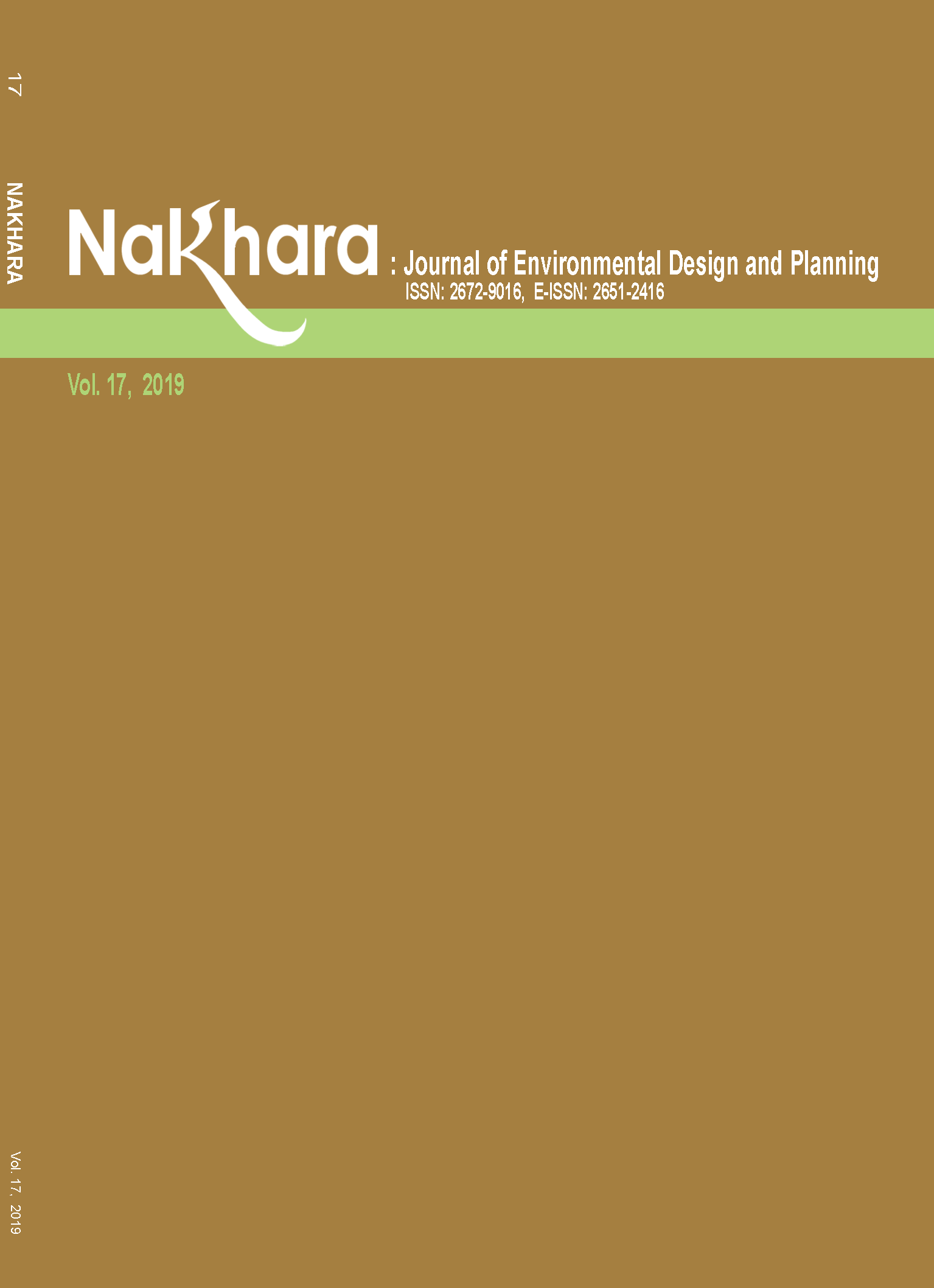Mono-Economy and Urban Vulnerability: A Case Study of Pak Phanang Municipality in Nakhon Si Thammarat Province
Main Article Content
Abstract
This paper examines the relationship between mono-economic growth and urban sensitivity. The selected case study is the Pak Phanang Municipality of Nakhon Si Thammarat Province, which has a mono-economy of bird’s-nest businesses as its main economic base. The research methodology was divided into three parts. Part 1 includes the study of changing urban morphology caused by the growth of the mono-economy and the evaluation of urban decline from decentralization according to the theory of spatial centrality. Part 2 studies the distribution patterns of spatial and social sensitivity, using quantitative research and an indicator-based approach from the Social Vulnerability Index. Part 3 determines the relationship between economic, social, and spatial sensitivities together with the concentration of the mono-economy by applying an overlay technique. The study indicated that the growth of the mono-economy from bird’s nest businesses in the city center caused urban decline due to two significant factors: (1) Changing urban morphology — the city was not able to attract employment and various economic activities, which accelerated the migration of the population; (2) Changes in the socio-economic structure of the city center — as seen in the socio-economic sensitivity index — it was found that the city center had a high concentration of bird’s nest businesses which was greater than other urban areas. Therefore, the results determine that the growth of the mono-economy was the root cause of urban decline and an increased urban sensitivity. One potential suggestion is to strengthen the economic base of the city and create a variety of urban conditions to solve the root problems and help decrease urban vulnerability.
Article Details

This work is licensed under a Creative Commons Attribution-NonCommercial-NoDerivatives 4.0 International License.
References
Alexander, D. E. (2002). Principles of emergency planning and management. Oxford: Oxford University Press on Demand.
Beauregard, R. A. (1993). Representing urban decline: postwar cities as narrative objects. Urban Affairs Quarterly, 29(2), 187-202.
Birkmann, J., & Birkmann, J. (2006). Measuring vulnerability to natural hazards: towards disaster resilient societies. New York: United Nation University.
Blaikie, P., Cannon, T., Davis, I. & Wisner, B. (2004). At risk: natural hazards, people’s vulnerability and disasters. 2nd ed. London: Routledge.
Burton, C., & Cutter, S. L. (2008). Levee failures and social vulnerability in the Sacramento-San Joaquin Delta area, California. Natural hazards review, 9(3), 136-149.
Chan, Y. (2001). Location theory and decision analysis. London: Springer.
Cutter, S. L. (1996). Vulnerability to environmental hazards. Progress in human geography, 20(4), 529-539.
Cutter, S. L., Boruff, B. J., & Shirley, W. L. (2003). Social vulnerability to environmental hazards. Social science quarterly, 84(2), 242-261.
Eakin, H., & Luers, A. L. (2006). Assessing the vulnerability of social-environmental systems. Annu. Rev. Environ. Resour., 31, 365-394.
Eraydin, A. (2013). “Resilience Thinking” in Planning Resilience thinking in urban planning, pp. 17-37. Dordrecht: Springer.
Ernstson, H., Van der Leeuw, S. E., Redman, C. L., Meffert, D. J., Davis, G., Alfsen, C., & Elmqvist, T. (2010). Urban transitions: on urban resilience and human-dominated ecosystems. Ambio, 39(8), 531-545.
Fekete, A. (2009). Validation of a social vulnerability index in context to river-floods in Germany. Natural Hazards and Earth System Sciences, 9(2), 393-403.
Fekete, A. (2010). Assessment of Social Vulnerability River Floods in Germany. Ph.D. Thesis, United Nations university, Institute for Environment and Human Security (UNU-EHS). United Nations University, Institute for Environment and Human Security (UNU-EHS).
Finch, C., Emrich, C. T., & Cutter, S. L. (2010). Disaster disparities and differential recovery in New Orleans. Population and Environment, 31(4), 179-202.
Folke, C. (2006). Resilience: The emergence of a perspective for social–ecological systems analyses. Global environmental change, 16(3), 253-267.
Hillier, B. (1999). Centrality as a process: accounting for attraction inequalities in deformed grids. Urban Design International, 4(3-4), 107-127.
Jacobs, J. (1961). The Death & Life of Great American Cities. New York: Random House.
Laursen, L. L. H. (2008). Shrinking cities or urban transformation. Videnbasen for Aalborg UniversitetVBN, Aalborg UniversitetAalborg University, Det Teknisk-Naturvidenskabelige FakultetThe Faculty of Engineering and Science, Center for Fysisk PlanlægningDanish Centre for Spatial Planning.
Laursen, L. L. H. (2009). Shrinking cities or urban transformation. Ph.D. Thesis. Institut for Arkitektur og Medieteknologi.
Martin-Breen, P., & Anderies, J. M. (2011). Resilience: A literature review. Retrieved from https://opendocs.ids.ac.uk/opendocs/handle/123456789/3692.
Schmidtlein, M. C., Deutsch, R. C., Piegorsch, W. W., & Cutter, S. L. (2008). A sensitivity analysis of the social vulnerability index. Risk Analysis, 28(4), 1099-1114.
Schmidtlein, M. C., Shafer, J. M., Berry, M., & Cutter, S. L. (2011). Modeled earthquake losses and social vulnerability in Charleston, South Carolina. Applied Geography, 31(1), 269-281.
Tontisirin, N., Marome, W. & Anantasuksomsri, S. (2016) Socioeconomic Risk Assessment of Flooding in the Urban Area of Udonthani for the Risk management of Climate Change. Faculty of Architecture and Planning, Thammasat University.
Tyler, S., & Moench, M. (2012). A framework for urban climate resilience. Climate and Development, 4(4), 311-326.
Wirth, L. (1938). Urbanism as a Way of Life. American journal of sociology, 44(1), 1-24.

